A Leaf of Deuteronomy from ‘Otto Ege Manuscript 14’ in the Rosenbrook Collection
February 8, 2022 in Manuscript Studies, Uncategorized
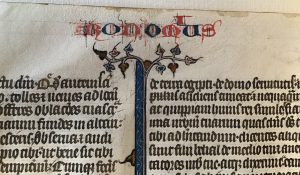
Brent Rosenbrook Collection, Leaf from Ege Manuscript 14, ‘Recto’ (original Verso), top: Running title.
An Old Testament Leaf
from ‘Otto Ege Manuscript 14’
with part of Deuteronomy
in the Rosenbrook Collection
Large-format Latin Vulgate Lectern Bible
made in France
late 13th- or early 14th century
Single Leaf within a matted frame
Double columns of 50 lines
Maximum measurements circa 16 1/8″ × 10 11/16″ <written area circa 11″ × 7 3/8″>
Deuteronomy 11:21 ([quam iuravit] /) dominus patribus)
– 14:15 (strutionem ac noc-(/tuam et larum])
With bichrome running titles and chapter numbers,
polychrome decorated initials and border ornament with geometric and foliate motifs,
and added lection marks
[Posted on 8 February 2022, with updates]
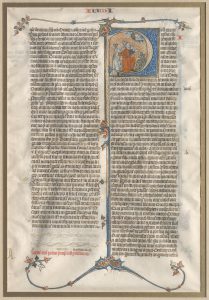
Virginia Lazenby O’Hara Fine Books Division, Dallas Public Library, Framed Leaf from Otto Ege MS 14, ‘Recto’ (original Verso).
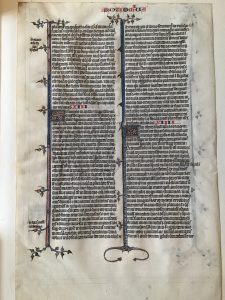
Brent Rosenbrook Collection, Matted Leaf from Otto Ege Manuscript 14, ‘Recto’ (original Verso).
Continuing the series of posts for our blog on Manuscript Studies, Mildred Budny describes another leaf from ‘Otto Ege Manuscript 14’, a large-format copy on vellum of the full Latin Bible in the Vulgate Version.
A leaf from this manuscript recently reached the collection of Brent Rosenbrook, who generously sent images and information about it, in response to the blogpost reporting More Discoveries for ‘Otto Ege Manuscript 14’.
A similar response several months ago brought to our attention the Dallas Leaf from the same manuscript, now kept at the Virginia Lazenbury O’Hara Fine Books Division of the Dallas Public Library in the City of Dallas, Texas. A report of that leaf, which carries the end of the Book of Joshua and the beginning of Judges in the Old Testament portion of the manuscript, appears in our blog on A Leaf in Dallas from ‘Otto Ege Manuscript 14’.
The ‘new’ leaf likewise comes from one of the early Books of the Old Testament. In the sequence, it stood one Book ahead.
Otto Ege Manuscript 14 and Manuscript Studies
Some discoveries for the manuscript have been reported in our blog.
- A New Leaf from ‘Otto Ege Manuscript 14’
- More Discoveries for ‘Otto Ege Manuscript 14’
- A Leaf from ‘Otto Ege Manuscript 19’ and Ege’s Workshop Practices
- Updates for Some ‘Otto Ege Manuscripts’ (Ege MSS 8, 14, 41, and 61)
- Some Leaves in Set 1 of ‘Ege’s FOL Portfolio’ (Ege MSS 8, 14, 19, and 41)
- Patch Work in ‘Otto Ege Manuscript 14’
- A Leaf in Dallas from ‘Otto Ege Manuscript 14’.
See also The Illustrated Handlist (Number 4).
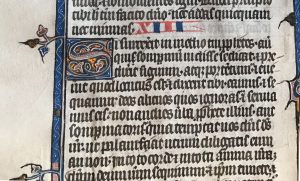
Brent Rosenbrook Collection, Leaf from Ege Manuscript 14, ‘Recto’ (original Verso), middle right: Deuteronomy 14 opens.
The Rosenbrook Leaf
When contacting me about the Leaf, its collector described the origins of his collecting spirit and the development of his book-collecting.
I wanted to give you a little bit of backstory and brief history. I am a layman in this field but have always been a collector of things since my childhood. I was a bibliophile long before I ever heard the term or would have understood its meaning. And although I am new to collecting illuminated manuscripts, I have always felt drawn to the beauty of them. As a teenager and young man I was especially stuck by the intricate, amazing imagery and knotwork in the Book of Kells. In 1998 I was fortunate to have visited Trinity College in Dublin and see it firsthand along with other books on display. It was a moment of wonder to finally be in the presence of that book. Although I never lost that sense of awe, for the next many years that was the extent of my experience and attention concerning manuscripts.
In December of 2016 my wife and I were visiting a friend’s home for the holidays when I noticed on the wall a large framed musical page of some sort. I could tell that it was hundreds of years old, handwritten, on animal skin. He knew little about it other than it belonged to a relative down the line and that at some point it was gifted to him. It was of course an antiphonal as I later discovered by searching online. It was (is) likely early 16th century and had one very large, but simple rubricated initial. Although it wouldn’t be considered elaborate or rare to a person knowledgeable in such things, for me the affect was basically “Wow, that’s really cool. I’ve got to figure out what that is. I want one of those”. The collector bug bit me again. . . .
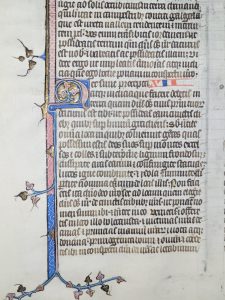
Brent Rosenbrook Collection, Leaf from Ege MS 14, ‘Verso’ original Recto), bottom left.
My interest and enjoyment of looking at and learning about illuminated manuscripts (especially Bibles with historiated and zoomorphic initials) grew as I visited multiple websites over many weeks and scrolled through countless images of various western manuscripts. In March 2017 I acquired my first true illuminated leaf when I bid on and (unexpectedly) won a large Bible leaf which was from a manuscript previously owned by the famous collector Chester Beatty. As far as the Otto Ege leaf, it was a spontaneous purchase.
I received a notification . . . when this page was listed recently by Rodger Friedman Rare Book Studio. It wasn’t on my radar (or necessarily in the budget) to make a purchase but after glancing at the listing throughout the day I committed to buying it. I only knew the name Otto Ege vaguely through my reading up on manuscripts.
When I received the package and saw the leaf for the first time it evoked a lot of emotion. Although I knew its measurements when I purchased it, I still wasn’t prepared for the size and beauty of seeing it firsthand – it is stunning. It was only in the last few weeks after this acquiring this that I began reading up on and watching video postings about this famous biblioclast and the sets he sold off. . . . It was just this past Thursday night when I came across the RGME website and decided to reach out to you.
As for the Leaf itself, the collector reports that “It remains in the original matting that Ege used when he compiled these books.” Thus, this specimen qualifies for the group of survivors from the manuscript which circulated on their own
, as a ‘Rogue Leaf’. Many of them traveled within one of Ege’s standard mats of a uniform size, accompanied by Ege’s printed Label giving a generic description of his Leaf 14. They resemble the presentation designed for specimen leaves from various manuscripts in Ege’s ‘FOL’ Portfolio of Fifty Original Leaves from Medieval Manuscripts, in which leaves from the dismembered Lectern Bible have the position of Number 14.
Now, with the collector’s permission, the Leaf might begin to assume its place within the virtual Reconstruction of the manuscript, as known from its fragments. Brent Rosenbrook observes:
I think it’s nice for others to know that there are those who aren’t necessarily part of academic institution but still would like to contribute what they can to the advance of manuscript study.
We greatly admire this view!
A Note on the Photographs of the Leaf
The images here show the Leaf and its details under several forms of light, taken at different times and at different angles. Their variety shows multiple aspects, including some 3-dimensional features which views at an angle can reveal of the curvature of the surface(s) of the animal skin and the furrows of the ruled lines upon it in drypoint.

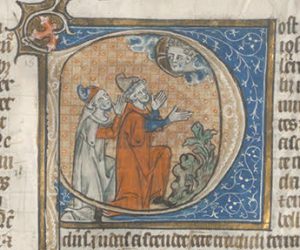
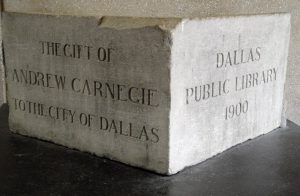
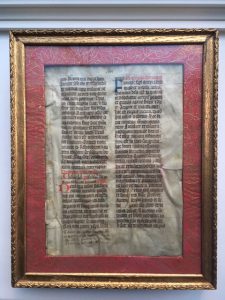
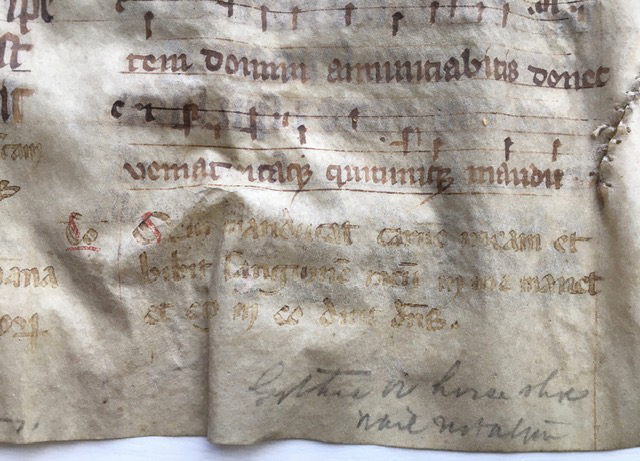
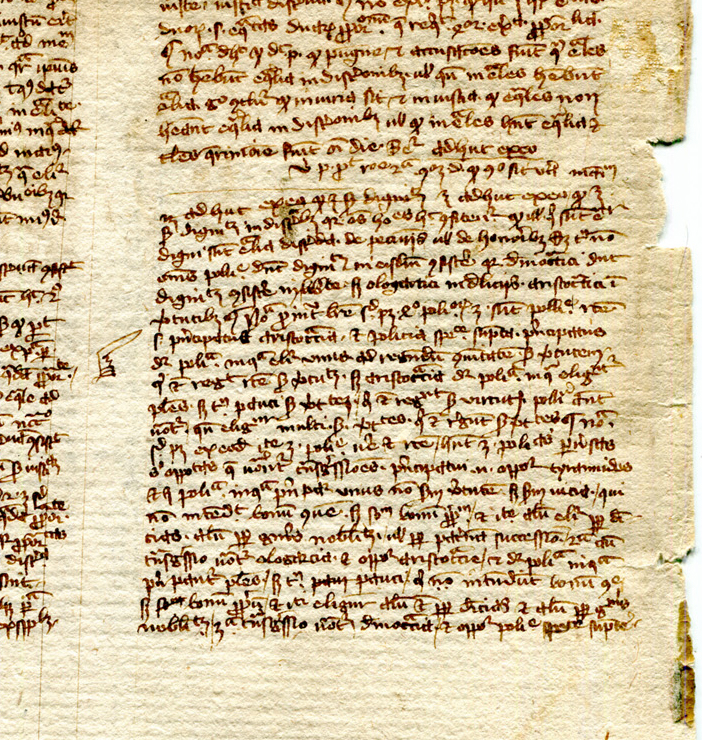
A Leaf from Gregory’s Dialogues Reused for Euthymius
December 24, 2016 in Manuscript Studies, Photographic Exhibition, Uncategorized
A Leaf from Gregory’s Dialogues
Reused for Binding
A Copy of
Euthymius Zigabenus’s On the Psalms
Budny Handlist 3
In our blog on Manuscript Studies (see its Contents List), Mildred Budny (see Her Page) continues to report the results of research for her Illustrated Handlist.
Here, we focus upon a leaf plucked from its 12th-century manuscript and pressed into service, with trimmed edges and mitered folds, as the vellum covering for a binding for a different text of small format. Both texts, primary and secondary in the life of the leaf, concern religious subjects, but they emanate from authors of different dates, locations, and languages in the Latin West and the Orthodox East respectively. The primary text represents a remnant of a text and an author familiar in some other blogposts, which consider the Dialogues, the Sermons or Homilies, and other texts by Pope Gregory the Great (pope from 590 to 694 CE).
Handlist 3, Recto
Handlist 3, Verso
Part of Gregory’s Dialogues, Book III, Chapter 7
(on Andreas, Bishop of Fondi/Fundi):
Sections 2 (Hic namque uenerabilis uir) –
8 (uel quae in conuentu)
Present measurements:
Circa 357 × 237 mm
< written area circa 266 × 133 mm >
Single column of 28 lines
in revived Caroline minuscule
without embellishments
Germany, circa 1175
Reused for some time as the vellum cover for the binding of a copy of
Euthymius Zigabenus‘s Commentary on the Psalms
in Greek or in Latin translation?
(now lost or preserved elsewhere in a location unknown)
For this secondary use, the remnants of a set of titles on the outside of the spine of the cover (the original verso of the reused leaf) remain in place, albeit abraded and fragmented, as both a pasted, inscribed paper label (orientated along the ‘horizontal’ across the spine) and an ink inscription on the reused leaf itself in Capitals (‘vertical’, with the tops of those letters turned toward the ‘front cover’). Another, smaller and fragmentary pasted label with a broad rectangular border stands near the bottom of the broad spine of the cover and partly overlies the ‘vertical’ spine inscription.
Acquired, probably by purchase (according to the Owner’s recollections), in France in the past 15 years or so, but before 2007 when I first saw and began to photograph the leaf. This item and others in the Illustrated Handlist acquired in France at various times and by various means (purchase, gift, or exchange), came from a single source in the Département of Saône-et-Loire, from about 1999 onward. Because the leaf does not carry indications of its original place and time of production, apart from its materials, layout, design, script, orthography, and punctuation, those unknowns must depend upon evaluations of the style of the script, lacking any forms of embellishment, such as decorated initials, which might have provided possibly more closely datable symptoms than the letters “alone”.
Read the rest of this entry →
Tags: 'Fifty Original Leaves from Medieval Manuscripts', Binding History, Bishop Andrew of Fundi, Budny's Illustrated Catalogue, Ege Manuscript 41, Euthymius Zigabenos, Fondi, Gregory the Great, Gregory's Dialogues, manuscript fragments, Manuscript Fragments Reused in Bindings, Manuscript studies, Psalter Commentary, Saki, Temple of Apollo
No Comments »